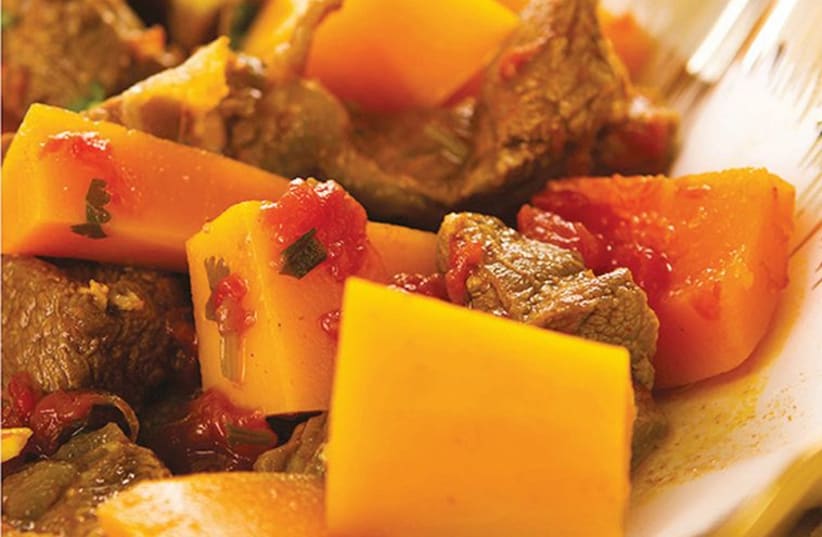BEEF TAGINE WITH BUTTERNUT SQUASH This recipe is from Sharing Morocco. “The squash picks up the cinnamon, giving it warmth and a slightly spicy flavor,” wrote author Ruth Barnes, commenting that this filling dish is perfect for cool days.Makes 4 to 6 servings❖ 1 Tbsp. sweet paprika❖ 1 tsp. ground ginger❖ 1 tsp. ground cumin❖ ½ tsp. turmeric❖ 1 tsp. cinnamon❖ ½ tsp. salt❖ ½ tsp. pepper❖ 1.35 kg. (3 pounds) boneless beef shoulder, cut into 2.5-cm. (1-inch) cubes❖ 3 Tbsp. olive oil❖ 1 large onion, diced❖ 5 garlic cloves, chopped❖ 1 400-gr. (15-ounce) can tomatoes, drained and diced❖ ½ bunch cilantro (fresh coriander), chopped❖ ½ bunch parsley, chopped❖ 1 large butternut squash, peeled and cut in cubes❖ 170 gr. (6 ounces) pearl or baby onions, peeled (see Note below) or thawed frozen baby onions❖ 1 cup chicken broth, preferably low-sodium, or vegetable stockIn a large mixing bowl, combine the paprika, ginger, cumin, turmeric, cinnamon, salt and pepper.Add beef to the mixture and stir well to season.In a Dutch oven, stew pan or large tagine suitable for cooking, heat the olive oil over medium-high heat. Sauté the onion and garlic for 5 minutes or until tender. Add the beef and brown on all sides.Stir in the tomatoes, cilantro, parsley, squash, pearl onions and broth, and bring to a boil. Cover, reduce heat and simmer for 1 ½ hours or until the beef is tender.Note: To peel fresh baby onions: Put onions in a saucepan, cover with water and bring to a boil. Cook 1 minute, rinse under cold water, drain well, and peel. (Frozen baby onions are already peeled.)SWEET-AND-SOUR PUMPKINThis recipe is from Cucina Siciliana. Author Clarissa Hyman sautés the pumpkin in olive oil that she first heats with garlic cloves, then marinates the pumpkin in a quick sweet and sour sauce with fresh mint leaves.Makes 4 servings❖ 4 Tbsp. olive oil❖ 4 garlic cloves, peeled❖ 1 kg. (2.25 pounds) pumpkin or butternut squash, peeled, seeds removed, sliced❖ 4 Tbsp. white wine vinegar❖ ¼ cup sugar❖ ¼ tsp. ground cinnamon❖ A handful of mint leaves, roughly chopped❖ Salt❖ Peperoncino (hot red pepper flakes) or black pepperHeat olive oil with garlic cloves in a large frying pan.Add the pumpkin in batches and cook until it chars around the edges, tossing and turning frequently; remove each batch with a slotted spoon when cooked. Remove the garlic when it turns brown; do not let it burn.Remove the pumpkin from the pan with a slotted spoon and arrange it in a serving dish. Discard the garlic.Sprinkle the vinegar, sugar, cinnamon, mint, and salt and pepper flakes to taste into the pan. Cook over medium heat for 1 to 2 minutes. Pour over the pumpkin.Leave to cool. Cover and chill for several hours before serving.TURKISH PUMPKIN DESSERT WITH WALNUTS AND PISTACHIOS Ayse Demirkan, who taught this dessert at a Turkish cooking class in her home, noted that you can garnish it with shredded coconut instead of or in addition to the nuts.You can also flavor it with cinnamon sticks or whole cloves, added to the pan with the pumpkin. If you wish to speed up the cooking, you can add about ¼ cup water at the beginning.In some homes the dessert is served with kaymak, a thick sweet Turkish cream; crème fraiche or sour cream are also options.Makes 6 to 8 servings❖ 2 butternut squashes (about 1.8 kg. or 4 pounds total), peeled and cut in 2.5- to 3.75-cm. (1- to 1½-inch) cubes❖ 1 to 1 1/3 cups sugar❖ ½ to 2/3 cup chopped walnuts (for sprinkling)❖ ½ to 2/3 cup chopped pistachios (for sprinkling)Combine the squash cubes and 1 cup sugar in a heavy, wide stew pan. If time allows, let stand for 15 to 30 minutes. Heat uncovered over low heat, stirring often, for 5 minutes.Cover and cook over low heat, stirring occasionally.The squash will give off liquid, which will turn into a syrup, that will begin to bubble. Continue cooking, occasionally stirring lightly, trying not to break up the squash pieces. After cooking the squash for 20 minutes, taste, and add more sugar if you like; stir sugar in lightly and continue cooking over low heat.Cook until the squash is very tender but still holds its shape and absorbs most of the liquid. The total cooking time is about 30 to 45 minutes. Do not let the squash caramelize.If there is too much liquid in the pan, continue simmering the squash uncovered until the mixture thickens.Transfer the squash to a serving dish, and spoon the syrup from the pan over it. Sprinkle with walnuts and pistachios.
Faye Levy is the author of the award-winning Faye Levy’s International Vegetable Cookbook.
Pumpkin with Mediterranean panache
It’s the flavorings that make Moroccan pumpkin soups taste different from French ones.
